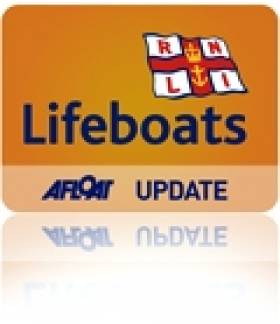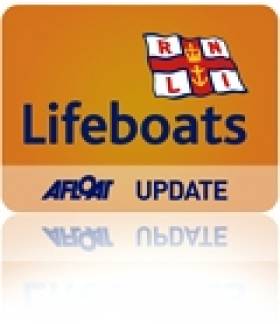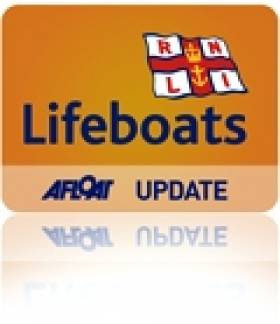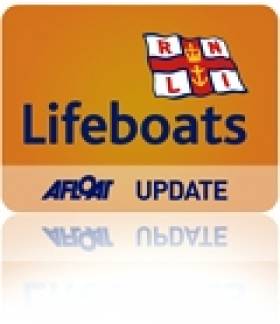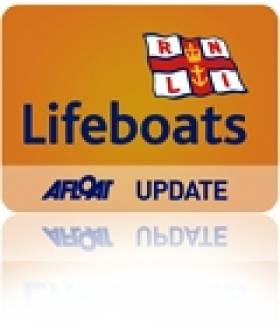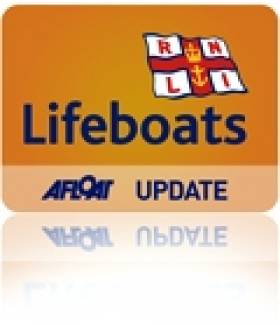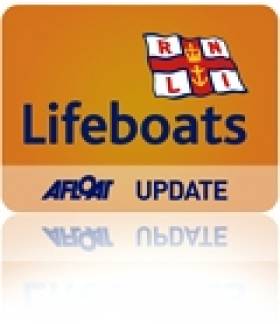Displaying items by tag: RNLI
'Duck Race' For Helvick Head RNLI Hailed A Success
#RNLI - The Duck Race in aid of the Helvick Head RNLI lifeboat station on Saturday 11 April 11th was a "spectacular success", according to race co-ordinator RoseAnn Foley.
As part of the Cois Cé celebrations during West Waterford Festival of Food, the 600 little yellow ducks entered the water from Devonshire Bridge in Dungarvan at 1.15pm with a lively commentary from Jenny Beresford and Sean Breathnach as they floated down Davitt’s Quay.
First prize in the Duck Race went to RNLI crew Liam Harty. Second was a photo finish between Séamus Kiersey from Ardmore and Tomás de Faoite ón Rinn, while third went to Tom Considine from Dungarvan and fourth went to Catherine Downey also from An Rinn.
Later, all the ducks were collected from the mud and were washed and put into storage until their next race.
And they weren't the only attraction on the day, with a free lifejacket clinic and sea safety check conducted by Austin Flynn also proving popular.
"We are very grateful to the public, Dungarvan Harbour Sailing Club, the kayakers, SGC and all our sponsors, West Waterford Festival of Food and the media for their enormous support," said Foley.
Bundoran Lifeboat Rescues Teen After Jet Ski Capsize
#RNLI - Bundoran RNLI rescued a teenager who fell from a capsized jet ski on Thursday afternoon (9 April).
The volunteer crew was requested to launch their inshore lifeboat by Malin Head Coast Guard at 1.24pm following a report that a jet ski had capsized a short distance from Bundoran Pier.
The lifeboat, helmed by Daimon Fergus and with crew members James Cassidy and Elliot Kearns on board, launched and made its way to the scene just a couple of hundred yards from the shore. Weather conditions at the time were described as good with the sun shining and the sea flat calm.
On arrival, the crew observed two males, one of whom had managed to get back on to the jet ski and a second who was still in the water.
The lifeboat crew pulled the teenager from the water and brought him back to shore where he was treated for hypothermia and the effects of having swallowed some sea water. He was subsequently transferred to Sligo General Hospital via ambulance as a precautionary measure.
"Thankfully, the lifeboat crew were able to assist this afternoon and bring this young man to safety," said Bundoran RNLI lifeboat operations manager Tony McGowan after the callout.
McGowan also encouraged anyone taking to the water "to enjoy themselves but be mindful that while the sun is shining and the weather is warm, sea temperatures are still very cold and it is important to dress appropriately bearing that in mind."
Bundoran's lifeboat crew were tasked again on Friday night (10 April) to reports of a red flare spotted over Rossnowlagh.
Following a call to Malin Head Coast Guard, the crew were paged just after 9pm and launched a short time later under cover of darkness, arriving at Rossnowlagh just before 9.30pm to commence a search of the area near Smugglers Creek. They were also joined by the Sligo-based Irish Coast Guard helicopter.
The search continued for approximately one hour before both crews were stood down and returned to base having found nothing.
Speaking on their return to the lifeboat station, volunteer helm Elliot Kearns said: "We would class this a false alarm with good intent and the member of the public who made the call was exactly right to call the coastguard. We would always rather be called to something that somebody was unsure about rather than a life be lost."
However, Kearns also urged anyone setting off Chinese lantern or lighting fires near the coast "to call the coastguard in advance to advise them. Of course if you see anyone in trouble at the coast please dial 999 or 112 immediately."
The callout was the third in a week for the Bundoran station, beginning with the rescue of a surfer in difficulty off Tullan Strand on Monday 6 April.
#RNLI - Arranmore RNLI saved two fishermen on Wednesday afternoon (8 April) after their 10m boat capsized off the Donegal coast.
A member of the public who was watching the fishing vessel from the shoreline raised the alarm at 2.50pm after he saw the boat capsize two miles south of Arranmore.
Arranmore RNLI’s boarding boat, which was already at sea with coxswain Anton Kavanagh and mechanic Philip McCauley on board, made its way to the scene.
Weather conditions at the time were described as blowing a gentle Force 2 to 3 wind but there was a heavy ground swell of three to four metres.
During their short passage, the volunteer lifeboat crew spotted and followed a track of fuel, and once on scene observed the wreckage of the stricken vessel. They then observed the two fishermen in the water approximately 300 yards from where the boat had capsized.
Both men were very cold when they were pulled from the sea and brought onboard Arranmore RNLI’s boat.
They were brought to Aphort Harbour, where they were made comfortable before being airlifted by the Irish Coast Guard’s Rescue 118 helicopter from Sligo and transferred to Letterkenny General Hospital.
Speaking following the callout, Anton Kavanagh said: "Both men are very lucky to be alive today and full credit must go to the member of the public who saw the boat capsize and raised the alarm, because the fishermen were not due back to shore for a couple of hours.
"We were delighted to be able to help and are glad that both men are safe and well."
Courtmacsherry RNLI Respond To Third Call-Out In 12 hours
#courtmacsherryRNLI – For many it was the end of the working week, but for members of the Courtmacsherry RNLI All weather Lifeboat Crew, yesterday evening was only the commencement of a very busy period of activity at sea, as it has now responded successfully to three rescues off our shores writes Vincent O' Donovan.
The All weather Trent Class RNLI Lifeboat was called out again this afternoon Sat at 3.50pm to respond to a Mayday call from a 55ft Fishing vessel that encountered difficulities just 2 miles south of the Old Head Of Kinsale in West Cork. In fresh winds blowing Force 5, with a two meter swell, the Lifeboat was away within minutes and located the casuality at 4.25pm and immediately secured a tow line. It has now brought the vessel under its control and is proceeding to tow the fishing boat, with six crew on board back to Kinsale harbour. As conditions at sea this evening are poor, its estimated time of arrival into Kinsale is 6.30pm.
Today's callout follows last evening rescue of a 60ft fishing vessel two Miles off The Seven Heads coastline which had got into difficulties at 5.40pm with 5 crew on board.As that Fishing vessel was safely berthed at Courtmacsherry Pier last evening at 8.45pm, an emergency call was received from Valentia Coastguard, that a large dog had fallen off the high cliffs at File Na Mho, near Broadstrand in Courtmacsherry Bay and that the owner who had tried to climb down the cliff to retrieve it, had failed and was in danger himself. The owner alerted the rescue Services through a 999 call and immediately, the Courtmacsherry Lifeboat responded. Within minutes at 8.50pm, the Lifeboat arrived at the Base of the cliffs and using its powereful engines and spotlights, located the stricken dog on the rocky waters edge.
Using its inflatable punt two members of the Lifeboat crew in special RNLI Lifeboat wetsuits suceeded in securing the Large Rhodesian Ridgeback and brought it to the safety of the Lifeboat, while the powerful Lifeboat Searchlights guided its owner to safety at the cliff top.
Twenty minutes later the owner and the large dog were both reunited in safety at the Lifeboat Station.
Dublin Bay Sailing Partnership Based on Artistic Endeavour
#iris – It has been said that keeping a boat-owning partnership intact is much more difficult than maintaining a marriage in a healthy state. Thus for most of us with the boat-owning vocation, sole ownership is the only way to go. But for others, in order to defray costs, increase boat size, and maybe leave more personal time free to pursue other interests, the ambitions can best be realised through one of a wide variety of partnerships and syndicates.
These can go through an extensive range, starting at one extreme with what amounts to time-sharing, with the large number of owners meeting (if they meet at all) only once a year for a sort of Annual General Meeting. Other possible setups can mutate through various arrangements where there is considerable overlap between the boat uses by the different owners, right through to the other extreme of total partnership where all owners sail together as often as is possible.
In some cases, the additional social glue of special shared interests is needed to give the partnership that essential extra vitality. There's nothing new in this. W M Nixon takes a look back a hundred years and more to a boat-owning group whose shared interest in art kept a 60ft ketch on a regular cruising programme around Dublin Bay and the nearby coastlines.
The 60ft gaff ketch Iris had a chequered career. She started life at the peak of the Victorian era in the 19th Century as a naval pinnace serving Dublin Bay, and she was presumably driven by steam. At the time, Dun Laoghaire – then known as Kingstown – was becoming the height of fashion as a naval port of call in the summer, made even more so by its convenient access to the centres of power in Dublin, and its strategically useful direct rail connection – pierhead to pierhead – to the main Royal Navy base in Ireland at Cobh on Cork Harbour.
However, as Kingstown had initially been planned solely as a harbour of refuge – an asylum harbor - for ships in distress in onshore gales, with the actual spur to its construction (starting in 1817) being the wrecking of a British troopship with huge loss of life at Seapoint on the south shore of Dublin Bay, the plans had included no provision for convenient alongside berthing for ships.
Indeed, you get the impression that the original underlying thinking was that there should be as little social contact as possible between ships sheltering in the new harbour and any inhabitants of its nearby undeveloped shore. But the rapid if somewhat chaotic growth of the makings of a new harbourside town, plus the advent of more rapid access from Dublin with the coming of the railway in 1834, soon meant that the top brass expected to be able to get off and on their ships in the harbour in style and comfort, and their Lordships of the Admiralty did not stint in providing large pinnaces for them to do so. When these pinnaces were replaced in due course by even more luxurious vessels, those shrewd amateur sailors who could visualise the older boats' potential as re-cycled government surplus found themselves looking at a bargain.
The Iris was originally built with lifeboat-style construction of double-diagonal hardwood planking, which was quite advanced technology for the time. For the can-do boatbuilders of the late 19th Century, converting such totally purpose-built craft into some sort of a yacht was all part of a day's work. Another similarly-built if smaller and different-shaped vessel, Erskine Childers' Vixen on which the Dulcibella of The Riddle of the Sands fame was based, was formerly an RNLI lifeboat with the standard lifeboat canoe stern. She was made more yacht-like by the addition of a staging aft to compensate for the absence of deck space just where you most need it, while underneath this new permanent staging, additional supporting planking was faired into the hull and – hey presto – you've a yacht-like counter stern.
Vixen also had a massive centre-plate complete with its huge casing, and carried more than three tons of internal iron ballast, all of which left little enough space for living aboard during the long and often rough cruise through the Friesian Islands which provided much of the on-the-ground material – and we can mean that in every sense – on which The Riddle was based.

Erskine Childers' Vixen (on which "Dulcibella of The Riddle" was based) in one of his last seasons of ownership in 1899. At first glance, she looks like a typical old-style cruising cutter of her era. But somewhere in there is a classic canoe-sterned RNLI lifeboat hull to which an afterdeck on a counter stern have been fitted as an add-on.
That cruise was in 1897, and shortly after it was completed, Childers went off to serve in the Boer War. This experience left him with doubts about the validity of the British Imperial mission, but equally left him in no doubt that on active service, there were no medals for enduring unnecessary discomfort. So by the time The Riddle of the Sands was published in 1903, Vixen was sold and he'd become a partner in a much more comfortable cruising boat, the yawl Sunbeam, which in turn was followed in 1905 by his very comfortable dreamship Asgard
Meanwhile, with the Iris a fifteen or so years earlier in Dublin, the conversion to a comfortable sailing cruiser was a more straightforward affair, as she'd a more versatile hull shape with a broad stern in the first place, and her new owner was one George Prescott, an innovator bordering on genius. He was an optical and scientific instrument maker, an electrical engineer and inventor, and a state-of-the-art clockmaker.
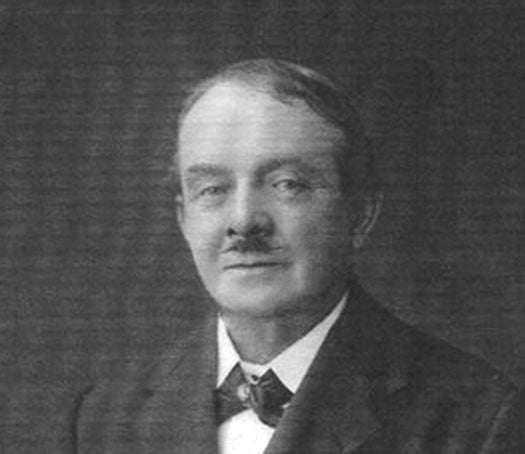
Man of many parts – the polymath George Prescott. Organising the Graphic Cruising Club and running its club-ship Iris was only one of his many interests. He led a long and extraordinarily interesting and varied life, and was nearly a hundred years old at the time of his death in 1942. Courtesy Cormac Lowth
But that was only one part of his life, for he had many friends among Dublin artists, particularly those interested in maritime topics, and he soon found himself to be the secretary of the Graphic Cruisers Club for sailing painters and sketchers, with the Iris becoming the base of their waterborne creative and scientific expeditions on the coast of the greater Dublin area.
She was ideal for this. She'd been converted for sailing with an orthodox gaff ketch rig, while her roomy hull was internally re-configured to have a galley with a large stove right aft, a huge saloon immediately forward of the galley to be both the clubroom and dining room, and sleeping quarters port and starboard in pilot cutter style forward of that.
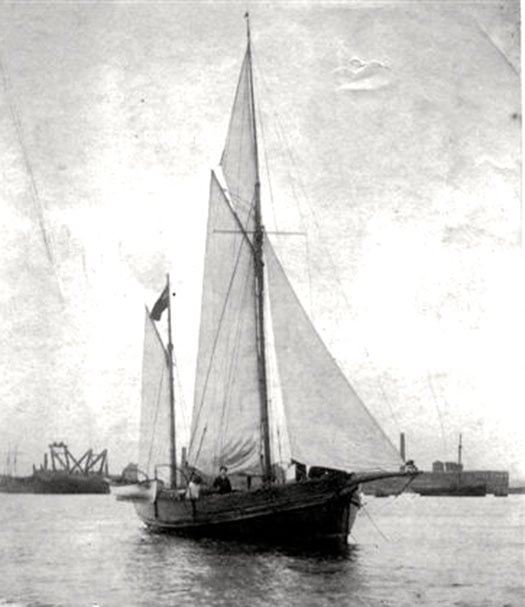
Quite a transformation for a former steam-powered naval pinnace. The 60ft ketch Irish in her heyday as the club ship of the Graphic Cruisers Club in the 1890s. She is at her home anchorage off Ringsend, while across the Liffey a couple of Ringsend trawlers are lying in the roadstead known as Halpin's Pool, where the Alexandra Basin is now located. Photo courtesy Cormac Lowth

Accommodation profile of the Iris in her days as the floating HQ of the Graphic Cruisers Club – this sketch by Alexander William first appeared in The Yachtsman magazine in 1894.
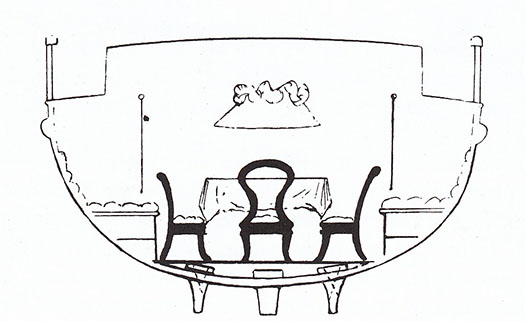
Hull section of the Iris at the saloon, showing the bilge keels which enabled her to dry out comfortably in some some little-known tidal anchorages in the Greater Dublin area.
But underneath the hull, the temptation had been resisted to add a deep keel, and instead the Iris was fitted with substantial bilge keels at the same depth as the shallow keel itself, such that in all she drew only about 3ft 6ins, and would comfortably dry out in a snug berth anywhere that her artistic crew felt they might find subjects worthy of their attention.
Thus she might overnight serenely on the beach at Ireland's Eye or far up the estuary at Rogerstown, and if the Graphic Cruisers Club attention was turned towards County Wicklow, she could comfortably take the ground in Bray or in other little ports inaccessible to orthodox cruising yachts. Yet the claim was that despite the odd arrangements beneath the waterline, she handled remarkably well on all points of sailing, and certainly as she no longer had any sort of engine, she must have sailed neatly enough to get out of some of the confined berths into which her eccentric crew enjoyed putting her.
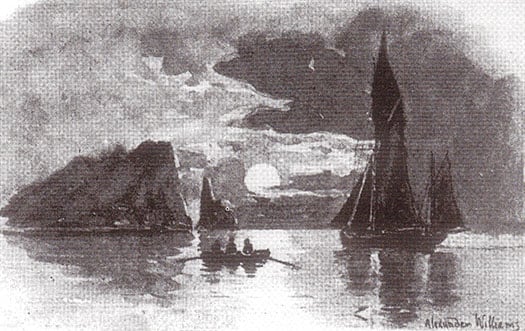
The Iris in gentle cruising mode off Ireland's Eye as the moon rises – this was sketched by Alexander Williams for The Yachtsman in 1894.
George Prescott seems to have been happy to claim that Iris was a club-owned yacht, but in truth most of his shipmates were impecunious artists of varying talent, so it was his generosity and understated business ability which would have kept the partnership together.
However, it really did seem to function as a partnership, for after the Iris project had been up and running for nearly a decade, he turned his attention in 1896 to building an unusual house on the waterfront on the Pigeonhouse Road in Ringsend, which he happily acknowledged to be the clubhouse of the Graphic Cruisers Club even if he lived in it himself.
Called Sandefjord for some reason which is still unexplained, it looked not unlike a smaller sister of the Coastguard Station next door, complete with a lookout tower. And it's distinctly nautical within, as much of the interior includes fine panelling which came from the wrecked Finnish sailing ship Palme, with the stairs being provided by the old ship's main companionway.
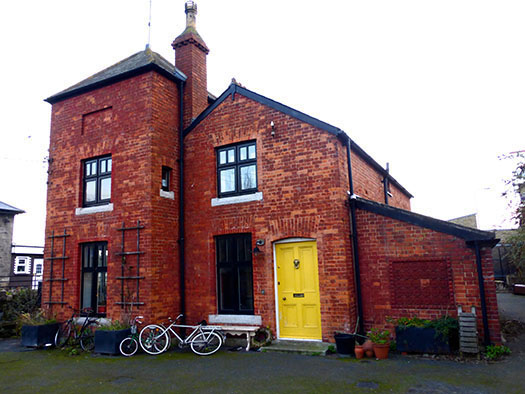
The house called Sandefjord near Poolbeg Y & BC as it is in 2015. When built by George Prescott in 1896, it faced across the Pigeonhouse Road directly onto the waterfront, and overlooked the summer anchorage of the Iris. Photo: W M Nixon
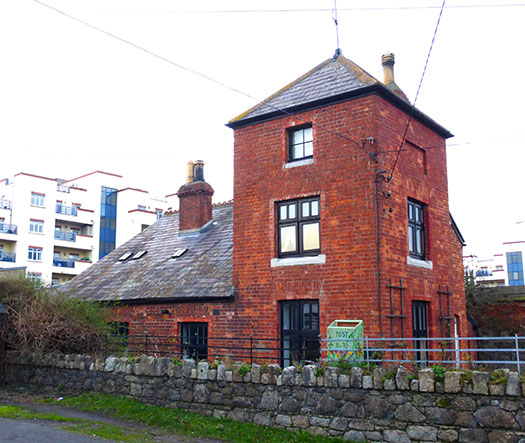
The design style of the Graphic Cruisers Club shore HQ at Sandefjord reflected the lookout tower of the old Coastguard Station next door. Photo: W M Nixon
The house has been restored to become a family home in recent years, and it really is an extraordinary piece of work to come upon on the slip road down to Poolbeg Yacht & Boat Club. Meanwhile, interest in the doings of the Graphic Cruisers Club has been restored by the formidable research talents and tenacity of Cormac Lowth, who single-handedly does more work in uncovering unjustly ignored aspects of Dublin Bay's maritime life in all its variety than you'd get from an entire university department.
I first came across a reference to the Graphic Cruisers Club years ago in an article in an 1894 issue of The Yachtsman magazine, written by Alexander Williams (1846-1930), who was probably the club's most accomplished marine artist. But that was then, this is now, and it has taken Cormac Lowth's dedication in recent times to get the extraordinary setup around George Prescott and Alexander Williams and their friends and shipmates into the proper context.
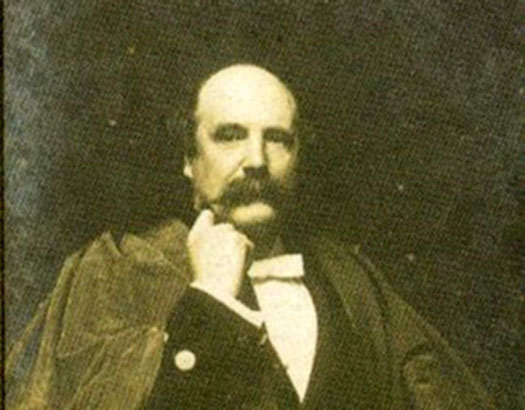
Alexander Williams RHA was the best-known artist in the Graphic Cruisers Club. A taxidermist of international repute, he was also a noted ornithologist, and his interest in maritime subjects was matched by his enthusiasm for landscape. He was one of the first artists to "discover" Achill Island in the west of Ireland, and in time he created a remarkable garden there in a three years project in which he personally worked shoulder-to-shoulder with the build team.
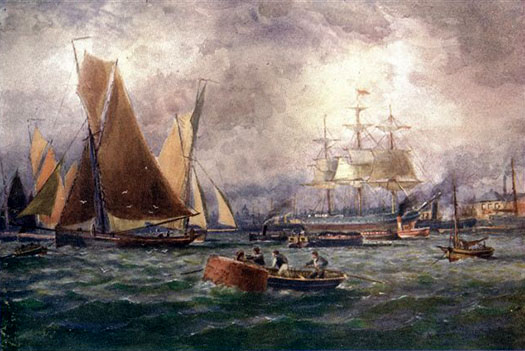
A classic Alexander Williams portrayal of the trawlers of Ringsend with other shipping in the Liffey. Thanks to research by Cormac Lowth, we are now aware of how the style of the Ringsend sailing trawlers came about through links, between 1818 and the 1914 outbreak of Great War, with the pioneering fishing port of Brixham in Devon, which was the most technologically advanced fishing port in Europe in the mid 1800s. Courtesy Cormac Lowth
They were larger than life, every last one of them, and Prescott and Williams in particular were renaissance men who could turn their hand to any number of creative projects at a time when life around Dublin was fairly buzzing for those with the energy and interest to enjoy it.
And there were links to other aspects of Dublin waterfront life which have a further resonance. Back in January, I'd to give one of the supper talks at the National YC in Dun Laoghaire, and on this occasion the topic was John B Kearney (1879-1967), the Ringsend-born yacht designer and boatbuilder who was the club's Rear Commodore for the last 21 years of his life.
You need some sort of special little link to bring these talks to life, but fortunately I remembered that there's a fine big Alexander Williams painting of sailing trawlers at Ringsend in the NYC's dining room. I didn't know its date as we headed round the bay on the night of the talk, but we struck gold. It was dated 1890.

The Brixham style in Ringsend was best exemplified by the largest trawler built in the Dublin port, the St Patrick (right) of 53 tons built in 1887 in the Murphy family's boatyard beside the mouth of the River Dodder. The Murphy family also owned and operated the St Patrick in her fishing, and when John Kearney built his renowned yachts, the earliest (and best) of them were built in a corner of Murphy's Boatyard - the Ainmara in 1912, the Mavis in 1925, and the Sonia in 1929. Photo courtesy Cormac Lowth
Williams was so fond of the Ringsend scene that he lived there for a while in Thorncastle Street where John B Kearney was born, and of course the painter subsequently sailed regularly from the old port in the Iris, and would have over-nighted at Sandefjord too. He is in fact the definitive Ringsend maritime artist, and the picture in the NYC expresses this. And as it includes some of the Ringsend waterfront, we could say that it also includes John B Kearney, for in 1890 the precocious eleven-year-old Ringsend schoolboy was in the boatyards as much as possible, as he had already stated in his quietly stubborn way that his ultimate ambition was to be a yacht designer.
Not a boatbuilder or a shipwright or a harbour engineer, which is nevertheless what he was until he retired in 1944. But upon his leaving the day job - in which he'd been highly respected - he then devoted all his energies to what he had been doing all his life in his spare time. And with his death aged 88 in 1967, his gravestone in Glasnevin cemetery said it all: John Breslin Kearney (formerly of Dublin Port & Docks Board) Yacht Designer.
And if you wonder how on earth we have come to a consideration of John Kearney's memorial stone in an article which purports to be about the social glues which keep boat partnerships in good order, believe me when you get involved with the boys of the Graphic Cruisers Club you never know where it's all going to end.
We've already discovered that in later life Alexander Williams devoted much energy to his garden in Achill while at the same time continuing to be an active member of the Royal Hibernian Academy in Dublin. As for George Prescott, he too broadened his already extensive interests, and in his eighties he was much into amateur opera production, even being so deeply involved as to paint the stage scenery himself.
Dublin too was expanding, so he accepted that a move eastward was needed if he was going to be able to continue to commune directly with his beloved sea. So he left Sandefjord, and the final decades of his wonderful life were spent at his new home at The Hermitage on Merrion Strand. Needless to say, Alexander Williams provided him with a painting of The Hermitage which captured the then unspoilt nature of a place you'd scarcely recognize today.
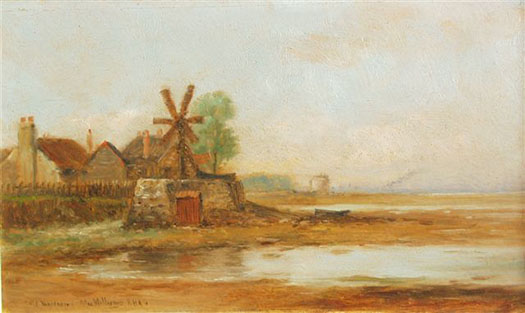
The Hermitage on Merrion Strand, George Prescott's last home as portrayed by Alexander Williams. Courtesy Cormac Lowth
Buncrana Welcomes New Shannon Class Lifeboat
#shannonlifeboat – Crowds turned out in Buncrana today to welcome a brand new €2.4 million lifeboat to its new home on the Donegal coast. The new boat that featured in today's Afloat enewletter has been warmly anticipate on the north coast. The Shannon class lifeboat is the first in the 191 history of the lifesaving charity that has been named after an Irish river, in recognition of the service and dedication of Irish lifeboat crews. It will be stationed at Lough Swilly RNLI.
The new lifeboat left RNLI Headquarters in Poole on Wednesday 1 April with a full crew and over the course of a ten day passage visited lifeboat stations at Newlyn, Aberystwyth, Douglas, Oban, Tobermory and Bangor before finally pulling in to its flanking station in Portrush, county Antrim from where it left in the early hours of this morning on the final leg to Buncrana. At 12 noon the lifeboat was escorted into Lough Swilly by a flotilla of boats to an emotional homecoming.
The lifeboat is named Derek Bullivant and has been largely funded through a legacy from Mr Derek Jim Bullivant of Bewdley, Worcestershire in the UK, who passed away in September 2011.
The Shannon is the latest class of all-weather lifeboat to join the RNLI fleet and the first to be propelled by waterjets instead of traditional propellers, making it the most agile and manoeuvrable all-weather lifeboat in the fleet. Waterjets allow the vessel to operate in shallow waters and be intentionally beached. The lifeboat has a top speed of 25 knots and a range of 250 nautical miles, which makes it ideal for offshore searches and rescues in calm and rough seas.
The new lifeboat was developed to operate in the worst of sea conditions and is self-righting, automatically turning the right side up in the event of a capsize. Its unique hull is designed to minimise slamming of the boat in heavy seas and the shock-absorbing seats further protect the crew from impact when powering through the waves.
The Shannon lifeboat also has another strong Irish connection. Peter Eyre, an RNLI Engineer from Derry who works at the charity's headquarters in Poole, was instrumental in the development of the new lifeboat, designing that unique hull form at the age of 24. Peter was present in Buncrana when the new lifeboat arrived into the harbour. He had a brush with the charity in 1998 when Lough Swilly Lifeboat came to his aid:
Commenting on the occasion Peter said, 'I have always had a link to the RNLI; it has been there in the background. I was just 14 years old when my family's 30ft cruiser racer yacht was dismasted in rough seas and force 7 winds. The yacht lost its mast and was escorted back to shore by the volunteer lifeboat crew.
I wish the Lough Swilly crew the best of luck with their new Lifeboat. I can tell how much this boat means to them. It is clear they will take great care of her and put her to good use as they bravely respond to people in distress. Knowing that I have designed a Lifeboat that will keep the crew safe when they launch into challenging conditions in their quest to save lives at sea makes me incredibly proud.'
The new lifeboat will replace the station's current all-weather Tyne class lifeboat Robert & Violet and will be the first all weather lifeboat that has been specially commissioned for the lifeboat station, the previous two have come from the RNLI's relief fleet.
The volunteer lifeboat crew will be busy training around the clock on the new lifeboat and when they are assessed as fully trained on it the new lifeboat will then officially be put on service. It will replace the Mersey and Tyne class lifeboats, which are now nearing the end of their operational lives. Once rolled out, the entire all-weather lifeboat fleet will be capable of 25 knots, making the lifesaving service more efficient and effective than ever before.
Speaking of the Buncrana Shannon homecoming event, Lough Swilly RNLI Lifeboat Operations Manager John McCarter added, 'This is an historic day for Lough Swilly lifeboat station. We were established as an inshore lifeboat station in 1988 and in 2000 received our first all weather lifeboat. This Shannon class lifeboat will be here for years to come and will come to the aid of many people over its lifetime. May our lifeboat crews always come home safe on her and may she bring many people home to their loved ones.'
Commenting on the arrival of the lifeboat Lough Swilly RNLI Coxswain Mark Barnett added, ' It is a very emotional day for everyone connected with the RNLI in Lough Swilly. So many people have made this possible and we are grateful for the continued support we receive and the great welcome from all the lifeboat stations we visited on our passage home. I would also like to acknowledge the incredible gift that the late Derek Bullivant has made to the RNLI, which allowed the purchase of this state of the art lifeboat and which will proudly bear his name.'
Lough Swilly's lifeboats have launched over 700 times and saved 47 lives, as well as bringing 517 others safely home, since its establishment in 1988.
#RNLI - Jack Lowe has loved the RNLI since he was a little boy. He became a member of Storm Force, the charity’s club for children, at the age of eight – about the same time he picked up his first camera.
Now, he’s bringing his two passions together in a unique undertaking: The Lifeboat Station Project.
Jack plans to visit all 237 RNLI lifeboat stations in Britain and Ireland, photographing the view from each station along with the crew and coxswain/senior helm using wet plate collodion, a Victorian process that allows him to record stunning images on glass.
The ambitious project is likely to take three to five years to complete. Jack, who lives in Newcastle upon Tyne, travels in 'Neena' — a decommissioned NHS ambulance purchased on eBay and converted into a mobile darkroom.
Grandson of Dad’s Army actor Arthur Lowe, also an avid RNLI supporter, Jack explains: "My early childhood was spent on a Victorian schooner in Ramsgate harbour and on the Thames. My Dad is an experienced seafarer and introduced me to the wonders of lifeboats – these wonderful, powerful pieces of kit designed for heroic, lifesaving missions on stormy seas.
"From an early age, I knew that I wanted to be either a photographer or a lifeboat crew member when I grew up. Now I’m following my heart and uniting the two dreams.
"I’m using a photographic technique developed in the 1850s, around the time that the RNLI was incorporated under Royal Charter. The photographs are made directly onto glass plates known as 'ambrotypes'." Jack has already documented all 15 stations on the East Anglian coast.
“The project now enjoys an incredible extra dimension as everyone is so involved and engaged with it," he says. "The coxswain and crew can step into the ambulance and watch a portrait of themselves developing. They are entranced, often rendered speechless and sometimes moved to tears!"
Jack began drawing up plans for the project over two years ago. He says he has always had an interest in the history of photography.
"The word photography means drawing with light and that is how I think about it still. I adore photography in this very raw, basic form — light falling on chemicals. It really is magical – the final image is always a surprise, even to me."
He adds: "There’s a small global community of people interested in using these old techniques. Everyone works in their own way – and you’re always learning as you go along.
"The chemicals are the original formulae from the 1800s. It took me a long time to figure out the logistics of transporting and storing glass plates. I have a box made for each station that holds 10 sheets of 10x12” glass. Then when I get them back to Newcastle I scan them, varnish them and then place them into storage."
It’s a real labour of love, even for a dedicated RNLI fan, but Jack always looks forward to his next station visit.
Follow Jack Lowe’s RNLI photographic mission on Facebook, on Twitter or on the project’s dedicated site.
Howth RNLI Announces Retirement of Lifeboat Operations Manager
#rnli – Howth RNLI has announced its Lifeboat Operations Manager (LOM), Rupert Jeffares will be retiring from his post after over 50 years of tireless dedication to Howth RNLI.
Mr. Jeffares has contributed to saving hundreds of lives at sea, since he joined as a volunteer crew member in the 1960's and in more recent years as he authorised the launch of Howth's lifeboats and assisted with the efficient management of the lifeboat station.
Last year, at the RNLI awards ceremony in the Barbican Centre in London, Rupert received a Bar to the Gold Badge, the second highest accolade awarded by the lifesaving institution in acknowledgement of his commitment to the charity.
Commenting on the announcement, Russell Rafter the Chairman of Howth RNLI said, 'He is a much loved, greatly respected and valued member of Howth RNLI, and will be sorely missed. We would like to invite all his friends, family and RNLI colleagues to mark Rupert's contribution to Howth RNLI with a reception and presentation in Howth Yacht Club at 8pm on Thursday 23 April'.
The new Lifeboat Operations Manager for Howth RNLI, Colm Newport, will take up his post at the start of May.
Bundoran Lifeboat Launches To Surfer In Difficulty
#Lifeboats - Yesterday evening (Monday 6 April), the volunteer crew of Bundoran RNLI were requested by the Irish Coast Guard at Malin Head to launch to a surfer in difficulty.
Shortly after 8pm, a passer-by noticed a female surfer in difficulty off Tullan Strand in Bundoran and immediately dialled 999.
Moments later the lifeboat crew were paged and within four minutes the Atlantic 85 lifeboat was launched from the pier, arriving on scene in under three minutes.
The crew brought the surfer and her surfboard on to the lifeboat and performed a quick medical check finding she was shaken but uninjured. The crew then returned to the station.
Speaking after their return, lifeboat helm Brian Gillespie said: "We are thankful to the member of the public who did the right thing by calling the coastguard.
"Darkness was beginning to fall and had it been any later the situation may have turned more dangerous. Thankfully the surfer is OK.
"As the weather is getting better, we want people to enjoy themselves but we would urge water users to exercise common sense and heed basic water safety principles.”
Kilkeel Lifeboat Manager Roy Teggarty Retires
#RNLI - Roy Teggarty has retired as lifeboat operations manager at Kilkeel RNLI in Co Down.
At a social evening in the local British Legion on Friday 27 March, Teggarty was pleased to greet fellow Kilkeel RNLI colleagues as well as staff and volunteers from neighbouring stations.
Coming from a fishing and nautical background, Teggarty was an obvious choice when in 1994 the lifeboat crew in Kilkeel were looking for a deputy landing authority (DLA).
He brought hard work, dedication and excellent organisational skills to the station ensuring, with the help of others in management, that the building and the equipment were always up to the required tasks.
In the year 2000, all his experiences were recognised when he was appointed as lifeboat operations manager (LOM). Over the years he has ensured that the crew have maintained the high professional standards they have always set for themselves.
Commenting on his years of service, Teggarty stated that the majority of callouts have been routine but, as always with this role, some have been very very dark tragic days.
"I have thoroughly enjoyed my time as DLA and LOM of Kilkeel RNLI, working with a dedicated team of volunteers, not only on the operational side but also with the excellent team of fundraisers," he said.
"Although I am standing down as LOM, I am sure that the station will continue to provide an excellent and professional service under the leadership of their new LOM John Fisher. I wish them all the best for the future in continuing to save lives at sea."
Thanking him for his many years of service, Leslie Campbell, Kilkeel RNLI volunteer lifeboat press officer, said: "The crew and fundraisers would like to wish Roy a long and rewarding retirement free from early morning alarm calls and thanks for your dedication, loyalty and years of faithful service."



























